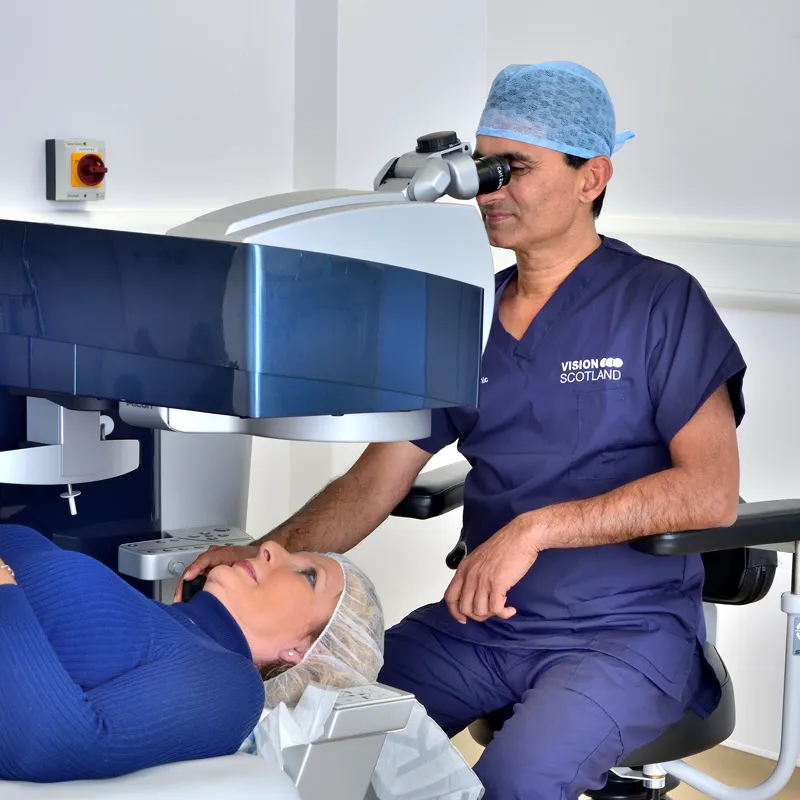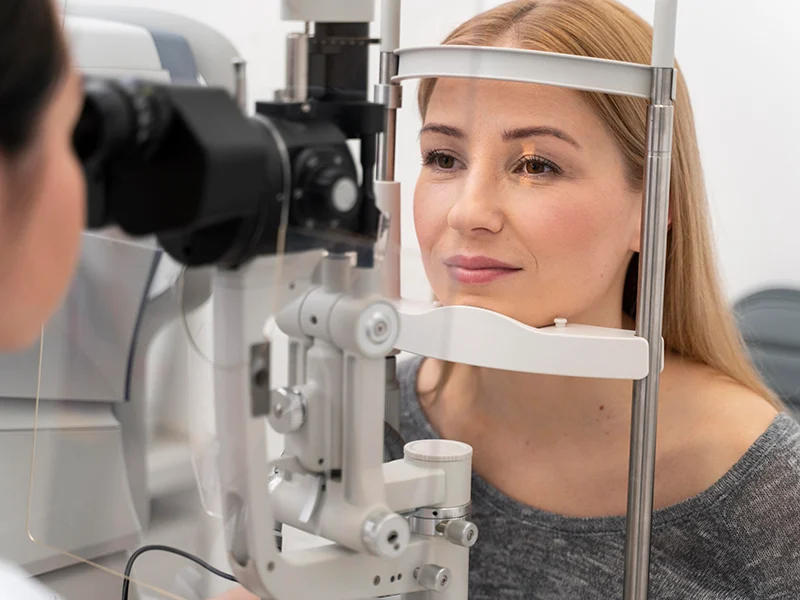How are you managing it?
Mr Jonathan Ross, in conversation with Ms Bita Manzouri, provides a personal perspective on challenge and opportunities shaping the future of cataract surgery services across the hospital eye service.
Redesigning cataract pathways in response to Covid-19.
Bita Manzouri:
Over the past year most NHS Trusts in the UK have stopped all elective surgical work, with their doctors and nurses being redeployed, and now are faced with huge backlogs, especially of cataracts. Now, more than ever, why do you feel that streamlining the national cataract are pathway is important?
Jonathan Ross:
The past year, marked by the COVID-19 pandemic, lockdown and unprecedented restrictions for elective care, is not something that we were prepared for or something that we expected to see in our careers.
But streamlining all care is extremely important now, and streamlining cataract surgery especially so. I characterise this as being a core component of quality of care. If you think about modern cataract surgery performed these days. It is an ongoing product of 70 years of evolution and refinement.
While contemporary cataract surgery is not a finished product, it is a very good product – and improvements now are diminishing. The big gain to be had in improving quality of cataract care is to improve access, so that everyone who needs it can benefit at an early stage.
As we emerge from lockdown and reinstate elective activity, we are going to find that there are enormous backlogs to manage, and additionally we are dealing with changed pathology in that people will be presenting with severe cataracts on a more regular basis, extending the duration of surgery and potentially leading to higher complication rates. So there are important reasons why we want to be looking at anything we can do to better use our valuable limited resources, which are operating theatres, skilled nurses and expert surgeons, to provide the care which is so desperately needed.
Higher volume cataract hubs : benefits and experience.
Bita Manzouri:
The Royal College of Ophthalmologists and Getting it Right First Time (GIRFT) have jointly produced a new document offering guidance and recommendations for setting up cataract hubs and high-volume cataract lists, to help improve patient care post-COVID-19 and help avert a full shutdown of elective cataract surgery amidst any future pandemic. Do you feel this high flow cataract surgery environment is beneficial and what is the patient / surgeon experience of working like this?
Jonathan Ross:
From personal experience, there are many benefits to dedicated high flow cataract hubs. In Scotland we have a form of national cataract hub, which is a non-general anaesthesia (GA) day case, six theatre purpose-built cataract centre. If you have an organisation where everybody is focused on one surgical procedure, it provides unique learning, audit and upskill opportunities, because all staff are immersed in a single care pathway. So I think this helps to evolve an end product in a shorter time and a better product that serves the patient more than if you don’t have that pooled care pathway process.
Across NHS eye units, the number of cataract cases per surgical list typically ranges from 5-12. Most high-volume cataract centres would be aiming for around 10-12 cases per four-hour theatre session, but this all depends on a really slick turnaround time and sufficient numbers of very experienced staff.
Bita Manzouri:
What role do these hubs serve with respect to training and development?
Jonathan Ross: Training is lifelong from a surgeon’s point of view. I would make no distinction between the needs of a consultant and a trainee in the sense that we all want to better ourselves, and to achieve this we need to maximise access to experiential learning and sharing expertise, and this means being in a facility providing high volumes of activity. When I joined Scotland’s high volume cataract centre in 2016, I had been a low volume
References:
- www.rcophth.ac.uk/wp-content/uploads/2020/08/resumption-of-cataract services-covid-august-2020-2.pdf
- www.rcophth.ac.uk/wp-content/uploads/2021/03/cataract-hubs-and-high-flow-cataracts-list.pdf
- www.nodaudit.org.uk/resources/publications-annual-report
- Itgo.ca/eyefoundationcanada/wp-content/uploads/sites/5/2020/06/2020-06-07-ISBCS-GLOBAL-SA.pdf
- AhmedIIK, Hill WE, Arshinoff SA. Bilateral same-day cataract surgery: an idea whose time has come #COVID-19. Ophthalmology 2021;128(1):13-4.
- O’Brart DP, Roberts H, Naderi K, Gormley J. Economic modelling of immediately sequential bilateral cataract surgery (ISBCS) in the NHS based on possible improvements in surgical efficiency. BMJ Open Ophthalmology 2020;5(1):e000426.
- Wang H, Ramjiani V, Raynor M, Tan J. Practice of immediate sequential bilateral cataract surgery (ISBCS) since COViD-19: a patient and surgeon survey. Eye (Lond) 2021:1-3.
- UKISCRS and RCO. Immediate Sequential Bilateral Cataract Surgery (ISBCS) during COVID recovery: RCOphth/UKISCRS rapid advice document. July 2020: https://www.rcophth.ac.uk/wp-content/uploads/2020/07/Immediate-Sequential-Bilateral-Cataract-Surgery-Guidance-2.pdf
- Lacy M, Kung TP, Owen J, et al. Endophthalmitis risk following same-day vs delayed sequential bilateral cataract surgery using the Intelligent Research in Sight (IRIS) Registry. Presentation at the Virtual ARVO 2021 annual meeting, 1-7 May 2021
- Manzouri B, De Lassus A, Ozturk M, Claoue C. Immediate sequential bilateral cataract surgery: experience from a secondary care centre in the UK. Presentation at the 37thCongress of the ESCRS, Paris, France; 14-18 Sep 2019
- Ben Hadj Salah W, Rousseau A, M’garrech M, et al. Assessment of the duration of surgery and patient turnover after the incorporation of a standardised intracameral combination of mydriatics and anaesthetics for cataract surgery. Cataract Refract Sur 2020;46(11):1487-94
(All links last accessed Aug 2021)
Table 1: UKISCRS and RCOphth: Surgical considerations for immediate simultaneous bilateral cataract surgery (ISBCS)*
- Concomitant ocular or periocular disease should be controlled and managed before surgery
- There should be a clear planning as to which eye to do first.
- To avoid wrong intraocular lenses and never events, particularly to minimuse the risk of right-left eye errors, existing RCOphth / UKOA guidance including using the WHO Surgical Safety operative checklist should be followed at the start of each eye as if it were a separate case. The surgical plan must be clearly differentiated for each eye (e.g. selected intraocular lens (IOL), astigmatism management) and all checks should include reference to source biometry documentation during safety checks.
- In the context of high refractive error, if expedited second eye surgery cannot be assured, ISBCS may be considered for unilateral cataract, but only usually if there are safety issues or if postoperative anisometropia cannot be managed in any other way (such as contact lens wear).
- Topical anaesthesia is preferred, with or without sedation, or sub-tenons in one eye only. It is preferable not to ‘block’ both eyes.
- Complete aseptic separation of the first and second eye surgeries is mandatory to minimis the risk of postoperative bilateral endophthalmitis. The following precautions are important safety arrangements for ISBCS:
- Before the operation of the second eye, the surgeon and nurse shall use scrupulous sterile routines treating each as a completely separate procedure with completely separate aseptic preparation.
- Theatre team to rescrub, re-gown, re-glove and undertake repeat prepping and draping of the surgical site.
- The separate instrument trays for the two eyes should go through complete and separate sterilisation cycles with indicators
- There should be no physical contact with or cross-over of instruments, drugs or devices between the two trays for the two eyes at any time before or during the surgery of either eye.
- Consider the use of disposable surgical instrument sets.
- Different batches/ lots of surgical supplies should be used for each eye; this should be specified on ordering.
- If possible, different IOL batches should be used for each eye; some very experienced ISBCS units do not make this stipulation, so long as the IOL manufacturer is reputable with a proven track record.
- Nothing should be changed with respect to suppliers or devices used in surgery without a thorough review by the entire surgical team, to assure the safety of proposed changed.
- Careful wound architecture and low threshold for suture use.
- Intracameral antibodies at the end of surgery are mandatory for both eyes, with an agreed local policy with respect to patients with known or suspected drug allergies – i.e. either use intracameral antibodies or do not proceed with ISBCS.
- Any issues with first eye surgery must be resolved before proceeding; if there is a suggestion that there is a significant complication in the first eye (including but not limited to capsule rupture, vitreous loss, zonular dialysis or increased surgical time for some other reason) especially if it increases the risk of endophthalmitis or other adverse outcome, second eye surgery must be deferred.
- It is important that, in training units, ISBCS does not reduce access to training opportunities. There should be particularly careful consideration of the level of trainee experience and performance and close supervision for trainees performing ISBCS cases. It is expected that initially a senior surgeon will do the first eye, and if uneventful it may be appropriate for a less experienced surgeon to undertake second eye surgery – this may change as units gain more experience in training on ISBCS cases.
- Extract adapted from UKISCRS and Royal College of Ophthalmologists. Immediate sequential bilateral cataract surgery (ISBCS) during COVID recovery: RCOpth / UKISCRS rapid advice document. July 2020. Courtesy of The Royal College of Ophthalmologists.




